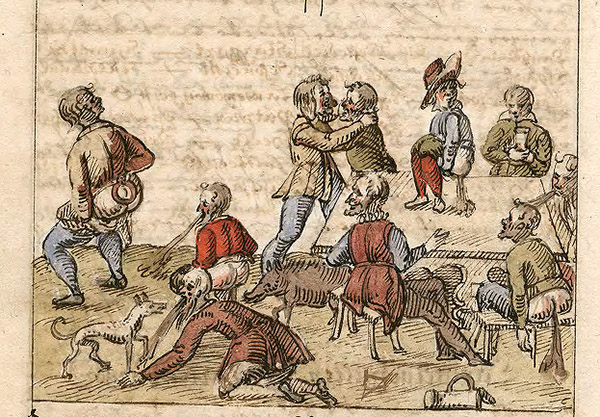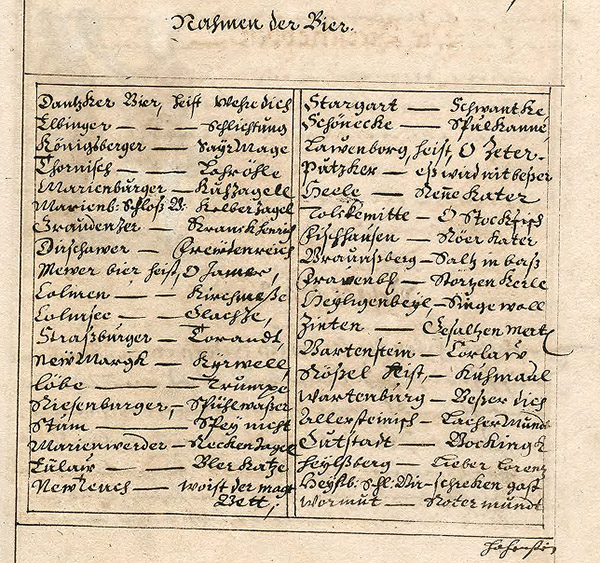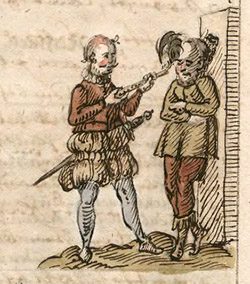Legend of Two Knight Brothers and Prussian Beer
One way or another, beer is mentioned in several Prussian legends. But today we will talk about perhaps the most famous "beer" legend, which tells how the names of Prussian beer varieties appeared back in the days of the German Order.
Thus, in the two-volume work by the German legend collector Johann Georg Theodor Gresse [1] “The Book of Legends of the State of Prussia” (Sagenbuch des preußischen Staats), published in Dresden in 1866–1871, in the section “West and East Prussia” there is a legend “About how they drank beer and what names the types of beer had in Prussia” (Vom Biertrinken und den Namen der Biere in Preußen):
In ancient times, the Prussians placed a sword and some money in the grave of the deceased, so that on the way to the afterlife he could at least buy himself some bread and a jug of beer, so as not to experience hunger and thirst.
The habit of drinking a lot of beer contributed to the emergence in the last century in many taverns of a law that anyone who did not finish the required portion to the bottom had to drink the same amount; a fine was established for violators: 22 shillings, a slice of bacon and a sheffel[2] kringel[3].
Under Hochmeister Konrad von Erlingshausen [4] (sic! - admin ), two idle Order brothers traveled throughout the country and gave each type of beer a special name.
Below is a list of Prussian cities and the names supposedly given by the knight brothers to the beer brewed in these cities. We will return to this list, which contains 58 names, a little later, but for now let's try to figure out where this legend "came from".
Gresse himself cites Kaspar Hennenberger [5] as the source of this legend, managing to make a mistake in the latter's name. Without specifying a specific work by Hennenberger, but only citing the page number - 475, Gresse (or his editor or typesetter) indicated the initial letter of Hennenberger's name as S instead of the letter K or C (Kaspar or Caspar) .
Hennenberger does indeed have a work, quite intricately titled, "Explanation of the large collections of land descriptions or maps of Prussia. With a brief discussion of all cities, castles, towns, villages, towns, rivers, streams and the sea. Also the legacy of cities and castles, their destruction and restoration. Examples of many beautiful and wonderful stories…” (Ercleru[n]g the Preüssischen large landowners or maps: When we talk about beer, wine, wine, beer, fire, fire, etc., we read so many beautiful stories. When we talk about beer, wine, etc., we talk about wide-ranging stories. Sometimes we read about wonderful histories), published in Königsberg in 1595, in which on page 475 we can read a “beautiful and wonderful story” – “About the brewers” (Von den Bier Scheppen; possible translation of the title – “About those who made beer”):
Under Hochmeister Conrad von Erlingshausen (sic! - admin ), two idle Order brothers traveled throughout the country and gave each beer a special name (Unter dem Hoemeister Conrado von Erlingshausen waren two Ordensbruder lose Buben in the Lande herum her name and one of the most popular beer names we have).
The following is a list of cities and the corresponding beer names, which Gresse repeated, with a few mistakes. The "story" ends like this:
…and they also say that Albrecht Mörlin's Chronicle is true. In the year 1443, the sun was shining on the captain and the ruler of the city made him feel like a monster while the weather was so hot and that he would be afraid of something else.
... and many other names are listed in the Chronicle of Albrecht Mörlin. But in 1443, the crimes of such brewers were discussed at the chapter and a sentence was passed - to burn a cross on the forehead with a hot iron and expel them from the Order lands [obviously, this refers to illegal brewers, meaning that they were not imprisoned, but, on the contrary, branded, ordered to leave the Order, so that everyone could see what had been done to them. - admin ] , which is what happened.


In the manuscript of the "Prussian Chronicle" (Secret State Archives of the Prussian Cultural Heritage Foundation (TGA PKN), storage unit XX. HA, Msc, A Nr. 14, p. 492: Mörlins Chronik - "The Prussian Chronicle is written aus des Alberti Morleins Buche"), written by Albrecht Mörlin (Albrecht Mörlin or Alberti Morleins) no earlier than 1523 (the events described in the chronicle end in 1523), not only "other names" but also no names of beer varieties at all could be found.
However, Hennenberger was not the first to provide a list of Prussian cities and the names of the beer brewed in them. In the "Prussian Chronicle" by Simon Grunau [6] (Simon Grunau's preussische Chronik - TGA PKN, storage unit XX. HA, Msc, A Nr. 6, pp. 117-118), which was published in Leipzig in 1877 under the editorship of Max Perlbach, in the chapter "Names [types] of beer in the state" (Namen der Bier im Lande) there is no mention of the knight brothers, but there is a list of cities and names of beer, and this list contains 51 names.



In addition to the Grünau manuscript, which is generally believed to have been written between 1517 and 1521, there is at least one other manuscript that offers its own version of the beer list and its own version of the legend. This is the Chronicle of Prussia (Cronica der Preussen), an illustrated manuscript written by Heinrich von Reden [7] and kept in the Berlin State Library. Two handwritten copies of the Chronicle, dating from the 1620s, are in Poland, in the library of the University of Toruń (storage units Rps 60/III and Rps 61/III).
Von Reden, narrating the events that took place in 1443, in the chapter "Brewers" (Die Bierscheppen) reports that at that time in the lands of the Order there appeared many breweries, and next to them taverns. Many young people who lived without the fear of God behaved inappropriately. They never sobered up and behaved unnaturally. So that everyone could recognize them, they were branded on the forehead with a red-hot iron.

In the Chronicle, von Reden also provides a list of beer names. However, unlike Grünau and Hennenberger, who list the city name in the left column and the beer name in the right, von Reden often lists not the city, but the "city beer", i.e. not "Danzig", but "Danzig", not "Elbing", but "Elbing", etc. In addition, von Reden has two names for Marienburg beer: for the city beer - Kuzagel, and for the beer from the Marienburg castle - Kelber Zagel. It seems that further down the list there is confusion, since the names of the beer varieties do not match the names of the cities listed by Grünau and Hennenberger.

It is difficult to determine what this is connected with. (Here it should be noted that we are talking only about a copy of the manuscript from the collections of the Toruń University Library under the number Rps 60/III , digitized and made freely available. It is possible that the original manuscript and the second Toruń copy differ from the specified copy.) In total, the von Reden list contains the names of 53 types of beer.

Why it happened that both Grünau and von Reden have a shorter list of beer names than Hennenberger can only be guessed at. The origin of the versions about the branding of the foreheads of either brewers or lovers of immoderate consumption of their products is also not entirely clear, as is the case with the two knight-brothers. Perhaps Hennenberger simply made up this whole story about the knights' wanderings across the lands of the Order and (what's the big deal) supplemented the list of cities that they allegedly visited. Or it may be that the beer brewed in different cities actually had names, and Hennenberger simply, in modern parlance, updated this list at the time of compiling his book. Well, Gresse, in turn, spiced up this "legend" with ancient Prussians and pretzels, managing, however, to make a lot of ridiculous mistakes.
Well, now, let us actually present the list itself, which has already been mentioned several times. The names of the cities in this list are given according to Simon Grünau (from 1 to 51) and Hennenberger (from 52 to 58). Unfortunately, we are unable to translate some of the names of beer varieties into Russian. Therefore, we will be grateful to our readers for comments and help with translation.
| No. | City name | Grunau | Hennenberger | Translation |
| 1 | Danzke (Gdansk) | Wehredich | What do you say? | Defend yourself! |
| 2 | Elbingk (Elbląg) | Schlichting | Schlichting | Simple/Cheap |
| 3 | Kingspergk (Kaliningrad) | Sawrmeig | Sawmill may | Sour Maid/Angry Maid |
| 4 | Thorn (Torun) | Laröll | Roloch or Loro | Lorelei/Roland or Lorelei |
| 5 | Marienburgk (Malbork) | Kuzagel | Kelber Zagel | Calf's tail |
| 6 | Graudentz (Grudziadz) | Kranc Heinrich | Kranc Heinrich | Sick Henry |
| 7 | Dirschau (Tczew) | Freudenreich | Freudenreich | Kingdom of Joy/Joyful to the Limit |
| 8 | Mewe (Anger) | About Jammer | About Jammer | Oh woe! |
| 9 | Neuburg (Nove) | Kirmesz | Kyrmes | Fair |
| 10 | Stargard (Starogard Gdanski) | Spule Kanne | Spülekanne | Enema cup |
| eleven | Culmen (Chelmno) | Glaze | Glaze | Baldness |
| 12 | Newteich (Novy Stav) | Schwente | Schwente | Shvente* |
| 13 | Strasburg (Brodnica) | Keyr wil | Kirbel | ??? |
| 14 | New Mark (Nowe Miasto Lubawskie) | Trumpet | Trumpet | Trump |
| 15 | Gerdawen (Railway) | Mommon | Mom or Mom | Mammon or Mumme** |
| 16 | Hiligenbeil (Mamonovo) | Salt Merten | Salt Merten | Salty Martin |
| 17 | Braunsbergk (Braniewo) | stortz curl | Sturzen Kerlen | Drunk kids |
| 18 | Tolkemit (Tolkmitsko) | Rhorkater | Rorkatter | Screaming cat |
| 19 | Molhause (Mlynary) | Krebs Jauch | Krebsjauche | Dung-beetle |
| 20 | Frawenburg (Frombork) | Singewol | Sing wol | Sing to your health |
| 21 | Czinten (Root) | Lurley | Lurley | Lorelei |
| 22 | Fridland (Pravdinsk) | Wolgemut | Wolgemuth | Zinger |
| 23 | Schippenbeil (Sempopol) | We are talking | Nasewisch | Handkerchief/Nose rag |
| 24 | Welaw (Znamensk) | Sole wurst | Sole or full crust | Regular sausage or Thick sausage |
| 25 | Bartenstein (Bartoszyce) | Khu maul | Kühmaul | Cow's mouth |
| 26 | Risenborg (Kentrin) | Kreisel | Krewsel | Spinning Top/Tempest |
| 27 | Neidenburg (Nidzica) | Krau mich | Klaw mich | Steal me |
| 28 | Resel (Reshel) | Besser says | Besser says | Become better |
| 29 | Allenborg*** (Friendship) | Dheisel | Dew or Shrug | Monster |
| thirty | Wartenbergk (Barchewo) | Lachermunt | Lachermundt | Laughing Mouth/Giggle Mouth |
| 31 | Allenstein**** (Olsztyn) | Bogkonig | Böcking or Borge nothing | Don't borrow! |
| 32 | Good City (Good Place) | Liber Lorentz | Dear Mr. Lorenz | Dear (Mr.) Lorenz |
| 33 | Heilsbergk (Lidzbark Warmiński) | Schreckengast | Schreckengast | Scare the guests |
| 34 | Libstat (Milacovo) | Wuistas | Wooow | Where is it? |
| 35 | Libemöl (Milomlyn) | Herlen mei | Harlemay | ??? |
| 36 | Eylau (Bagrationovsk) | Wait is the best | What is the matter? | Where the maid prayed/Where is the maid's bed |
| 37 | Hogenstein (Olsztynek) | I'm stuck | I'm stuck | I'm holding this |
| 38 | Kreutzborg (Slavskoe) | Mengs wol | Menge es wol | It's enough |
| 39 | Passenheim (Pasym) | Schlecke brey | Squeezing and flickering | Thick beer or Smoked beer |
| 40 | Marienwerder (Kwidzyn) | Blerkatz | Blerrkatze***** | ??? |
| 41 | Reden (Reda) | Sausage wind | Sausagewindt | Fidget/Frivolous |
| 42 | Melsack (Penenzhno) | Lertash | Leertasche | Empty pocket |
| 43 | Wormith (Orneta) | Kinast | Kinast | ??? |
| 44 | Moringk (Morong) | One danck | Oh, come on! | Do not mention it |
| 45 | Stumb (Stumb) | Recken Zagel | Reckenzagel****** | Skirt hem |
| 46 | Risenborgk (Prabuts) | Spey nit | No Spey | Don't spit |
| 47 | Colmensee (Chelmza) | Durant | Durant or Tarant | ??? |
| 48 | Vischhause (Primorsk) | Schlepenketel | Snacks or Salts are | Old robe or ??? |
| 49 | Luben (Lyubava) | Sturtzing | Strutting or Spray Water | Thinking too much of yourself (beer) or Slop |
| 50 | Holland (Solanum) | Filletwurst | Full meal | Thick sausage |
| 51 | Osterode (Ostruda) | Dinne becke | Dunebacks | Sunken cheeks |
| 52 | About the Schlos (???) | Reckenzagels Mutter | The hem of the mother's skirt | |
| 53 | Rosenburg (Dry?) | Krause müntte | Curly mint | |
| 54 | Lawenburg (Lebork) | It doesn't matter | It won't get better | |
| 55 | Stolpe (Slupsk) | Nope | Don't spread it | |
| 56 | Pautzke (Puck) | Rennenkatter | The running cat | |
| 57 | Hela (Hel) | About Stockfish | Oh, dried fish | |
| 58 | Schönecke (Skarszawa) | About Zetter | ??? |
* Švente is the name of the river that flows through the city (the Polish name of the river is Šventa); the waters of the river were not distinguished by their cleanliness or transparency.
** It is possible that the name “Mumme” is somehow connected with the Mumme beer, which was popular since the end of the 14th century – a dark, strong and sweet ale brewed in Braunschweig.
*** Gresse "Altenburg". Neither in West nor in East Prussia was there ever a city named Altenburg.
**** Gresse again mistakenly calls the city "Altenburg"
***** at Gresse's "Bierkatze"
****** at Gresse's "Rockenzagel"
Notes:
1. Johann Georg Theodor Grässe (1814 – 1885) – German literary scholar and bibliographer, author of several books on the history of literature, and compiler of collections of German legends.
2. Scheffel is a unit of volume of bulk solids used in German-speaking countries and differing at different times and in different places. The Königsberg old sheffel had a volume of approximately 50 l, the Danzig old sheffel - 51.5 l.
3. Kringel - pretzel
4. Konrad von Erlichshausen (1390 or 1395 – 1449) – 30th Supreme Master of the Teutonic Order from 1441 to 1449. In some sources, this surname is also written as Erlingshausen.
5. Kaspar Hennenberger (Kaspar or Caspar Henne(n)berg(er), 1529-1600) - German historian, cartographer, graduated from the University of Königsberg and, starting in 1554, served as a Lutheran pastor in the churches in Domnau (now Domnovo, Kaliningrad region), Georgenau (Roshchino), Mühlhausen (Gvardeyskoye). From 1590 he was a priest at the Löbenicht hospital in Königsberg.
6. Simon Grunau (c. 1470 – 1530 or 1537) – Dominican monk and chronicler who wrote the Prussian Chronicle and compiled a Prussian-German dictionary. Modern researchers question the veracity of much of the information contained in the Prussian Chronicle.
7. Heinrich von Reden (1510-1569) - a native of Danzig, a merchant. Between 1553 and 1556 he wrote the illustrated "Chronicle of Prussia". The "Chronicle" contains many errors both in dating and in illustrations, most likely not made by the author himself and varying in quality in different copies.
